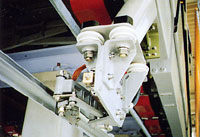MECHANISM
Levitation
 Attractive force between rail and electromagnets attached to module makes vehicle levitated. The force is controlled so that gap between rail and magnet is constant with gap sensor. Lateral fluctuation is automatically adjusted by attractive force between rail and magnet.
Attractive force between rail and electromagnets attached to module makes vehicle levitated. The force is controlled so that gap between rail and magnet is constant with gap sensor. Lateral fluctuation is automatically adjusted by attractive force between rail and magnet.

Running by linear motor
Linear motor is an rotary induction motor that spreads out flat. Rotary motor generates rotary force but linear motor generates straight force. Primary coil of linear motor corresponds to that of rotary motor that spreads out flat and is attached to vehicle and reaction plate corresponds to aluminum rotor that spreads out flat and fixed on rail.
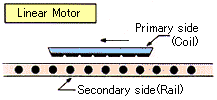
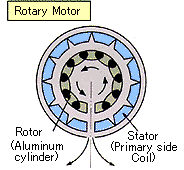
Module
Module corresponds to bogie of conventional railway. One module has four electromagnet coils for levitation and guidance, one linear motor coil and a mechanical brake system. There are six modules in a 100S car and ten in a 100L car. This structure makes track simple and makes vehicle run smoothly.
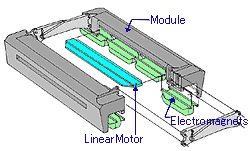

Electromagnets
One module has four electromagnet coils. They consume 275 voltage direct current. In case of power failure, batteries keep modules levitated until vehicle stops.

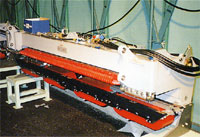
Linear motor
Each module has one linear motor coil and vehicles possess the performance to run at 100km/h. Motors are controlled by a small-sized, light-weight VVVF inverter controller.

